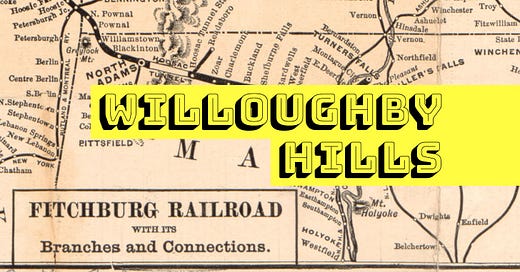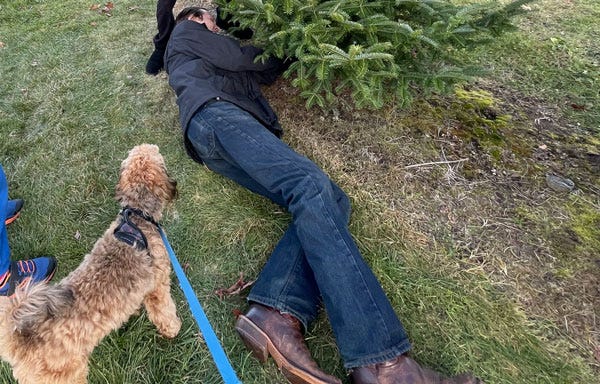Wednesday Walk: Railing for Rails
Feeling helpless over Gaza, Wishing for trains, and repairing old denim
Welcome to Willoughby Hills!
If you enjoy what you’re reading, please consider a free subscribtion to receive emails every Wednesday and Sunday plus podcast episodes every two weeks. There are also paid options, which unlock even more features.
As is typical every Wednesday, I’m bring you a smattering of topics that I hope will make you a bit more curious about the world around you and give you something to think about later. I call these Wednesday Walks, as it’s the type of conversation we might have walking down a path in the woods. Shall we take a stroll?
Watching and Waiting
As you have probably picked up in reading this newsletter recently, I have been increasingly frustrated with the lack of action on the part of U.S. politicians as the death toll in Palestine continues to climb.
Al Jazerra is reporting the death toll as north of 15,000 people in Gaza at the moment. I feel like every time I go to write a new issue of this newsletter, the number of dead has increased even more in just a matter of days.
It can be easy to hear the number and think about it in the abstract. But I try to imagine the lives and stories behind the numbers, trying to think of what each of those individuals lost meant to friends and family.
Against these rising daily numbers, there’s also a helplessness that I feel. What can I really do to help end the suffering on the other side of the world? My only choice is to witness and speak out, because I’m not in a position to stop the bombings myself.
There’s also a strange sense of déjà vu that I haven’t been able to quite place until recently. The feelings that I’m having today are exactly how I felt at the beginning of the pandemic, as the daily death toll grew and grew with no end in sight and inaction from those in charge.
I had just launched my podcast in early 2020, and I remember checking the death toll before recoding many of my opening monologues. In those early days, it was in the tens of thousands: 20,000, then 40,000. At some point, it became hundreds of thousands. According to the CDC, three and a half years later, we now stand at 1.15 million dead from COVID in the U.S. It’s hard to fathom.
I suppose climate change also fits into this category of watching terrible things happen and seeing leaders unable or unwilling to respond.
What is it going to take to get some action on all of these fronts? What is it going to take to get some action on any of these fronts? I wish I had the answers. Today, I’m just watching the numbers climb and hoping that the right people intervene.
Longing for Locomotives
If you traveled by air over the holiday weekend, you were not alone.
According to U.S. Secretary of Transportation Pete Buttigieg on Threads :
I don’t want to assume Secretary Pete’s intentions with this post, as “record breaking” might merely be an objective way to describe one of the heaviest air travel days in history. Perhaps I’m projecting or running his post through my own filter when I read his “record breaking” as celebratory.
To me, a record day for air travel is a cause for alarm and it shows how much work there still is to do in the United States.
According to a study published in 2020, air travel is responsible for about 3.5% of climate change. The effects of a warming planet are no longer distant or abstract. They are here now and will continue to increase in frequency and severity. The time to invest in a robust national network of high speed trains was decades ago, and the longer we wait, the longer it will take to undo the climate damage.
There are small examples of high speed rail in the United States, but nothing that knits together the entire country in a fast and efficient way. The Brightline trains in Florida now connect Miami to Orlando in about 3.5 hours and can reach speeds of 125 miles per hour in some areas.
The train ride between the cities is similar to driving in terms of travel time, but there’s still the issue that the train connects two sprawling, car dependent cities, so once you arrive at either end of the line, you would still need to rent a car or hop in an Uber to reach your final destination. Which makes me wonder who Brightline is built for and who would opt to take it?
The sad thing about the state of U.S. rail travel is that we once had an incredible system that connected thousands of small towns across the entire continent. It may not have been fast by today’s standards, but it brought us together.
I live down the street from an old railroad depot that once carried cargo and passengers between Boston and either Troy, NY, Saratoga, NY, or Bennington, VT. With a connection, a passenger could start in my neighborhood and reach Worcester, Northampton, or Holyoke. Henry David Thoreau described this same rail line in Walden, as his cabin was within ear shot of the train tracks, as were thousands of homes across New England and New York.

These days, some portions of the Fitchburg Railroad tracks are still in use, connecting commuters traveling from Gardner, MA into Boston, with 17 stops along the line. It’s not designed with long haul travel or distant visits in mind. The stations that do have parking often don’t allow it overnight and service is most frequent during weekday bankers hours.

I suspect that in my lifetime, air travel will still make sense for certain trips. Traveling between New York and Los Angeles by jet is still probably the most practical option for most people.
But I wonder if last Sunday would have been as “record breaking” in airports if we had a robust rail system that gave people fast, efficient, clean, and safe options to travel between Los Angeles and Las Vegas. Or Cleveland and Columbus. Or Saint Louis and Kansas City. Or Chicago and Minneapolis. Or Nashville and Memphis. Or Houston and Dallas. Or…
No New Clothes
While my year without buying any new clothes officially came to a close a few weeks ago, I am still being very mindful of what I am buying. Other than one shirt at a Disney Outlet in Florida over the summer, I have been able to go more than a year without buying any other new clothes. This includes socks, underwear, everything.
I did buy three thrifted shirts over the weekend, including two vintage Sears shirts. I’ll share photos of them at some point soon. There was a 50% off sale for Black Friday at a thrift store that always has good finds and some 70s Sears shirts (and a more modern Ben Sherman) were hard for me to pass up at under $10 for all three.
At any rate, even though the official challenge has ended, I missed having a place to regularly talk about ways to be more conservative about fashion purchases. I thought I would occasionally bring back some ideas to these Wednesday Walks.
It’s old news at this point, but I recently learned that France has started to subsidize clothing repairs, offering anywhere from a €6 to €25 subsidy, depending on the complexity of the repair. The goal is to keep old clothes lasting longer and to encourage French citizens to buy higher quality clothing that can easily be repaired if need be.
Speaking of repairs, a few weeks ago, I shared that I was looking to darken my old jeans, which came in a deep indigo but had faded over time. I found a good tutorial on YouTube and tried using Rit brand dye, which was about $3 at Target.
I ended up dying two pairs of jeans, one at a time.
I’m honestly not crazy about how the first pair came out- it doesn’t look like I did much to them and I’m not sure that it was worth the effort. But for the second pair, I used extra hot water and kept the jeans in the dye for 90 minutes instead of 60. They look brand new again!
I’m happy that more people (including me!) are discovering repair and revitalization over buying new and I hope the French model spreads to other places as well.
I publish new issues every Wednesday and Sunday. Sign up to always receive the latest issue and support my work:
Other Wednesday Walks
If you’ve missed past issues of this newsletter, they are available to read here.






